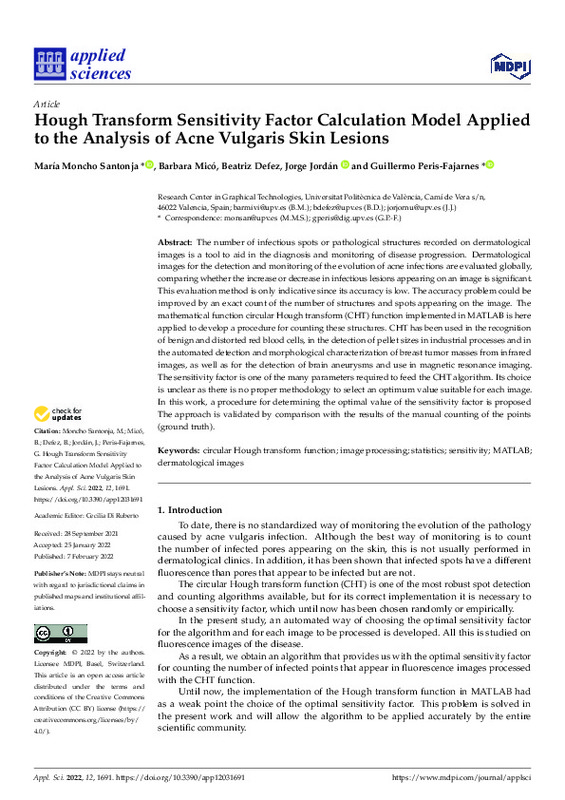JavaScript is disabled for your browser. Some features of this site may not work without it.
Buscar en RiuNet
Listar
Mi cuenta
Estadísticas
Ayuda RiuNet
Admin. UPV
Hough Transform Sensitivity Factor Calculation Model Applied to the Analysis of Acne Vulgaris Skin Lesions
Mostrar el registro sencillo del ítem
Ficheros en el ítem
| dc.contributor.author | Moncho-Santonja, María
|
es_ES |
| dc.contributor.author | Micó-Vicent, B.
|
es_ES |
| dc.contributor.author | Defez Garcia, Beatriz
|
es_ES |
| dc.contributor.author | Jordán-Núñez, Jorge
|
es_ES |
| dc.contributor.author | Peris Fajarnes, Guillermo
|
es_ES |
| dc.date.accessioned | 2022-03-23T19:03:16Z | |
| dc.date.available | 2022-03-23T19:03:16Z | |
| dc.date.issued | 2022-02-07 | es_ES |
| dc.identifier.uri | http://hdl.handle.net/10251/181515 | |
| dc.description.abstract | [EN] The number of infectious spots or pathological structures recorded on dermatological images is a tool to aid in the diagnosis and monitoring of disease progression. Dermatological images for the detection and monitoring of the evolution of acne infections are evaluated globally, comparing whether the increase or decrease in infectious lesions appearing on an image is significant. This evaluation method is only indicative since its accuracy is low. The accuracy problem could be improved by an exact count of the number of structures and spots appearing on the image. The mathematical function circular Hough transform (CHT) function implemented in MATLAB is here applied to develop a procedure for counting these structures. CHT has been used in the recognition of benign and distorted red blood cells, in the detection of pellet sizes in industrial processes and in the automated detection and morphological characterization of breast tumor masses from infrared images, as well as for the detection of brain aneurysms and use in magnetic resonance imaging. The sensitivity factor is one of the many parameters required to feed the CHT algorithm. Its choice is unclear as there is no proper methodology to select an optimum value suitable for each image. In this work, a procedure for determining the optimal value of the sensitivity factor is proposed The approach is validated by comparison with the results of the manual counting of the points (ground truth). | es_ES |
| dc.description.sponsorship | This work was supported for publication by the Conselleria de Innovación, Universidades, Ciencia y Sociedad Digital of the Generalitat Valenciana. All this work has been done in the CITG (Research Centre in Graphic Technologies) at the Universitat Politècnica de València. | es_ES |
| dc.language | Inglés | es_ES |
| dc.publisher | MDPI AG | es_ES |
| dc.relation.ispartof | Applied Sciences | es_ES |
| dc.rights | Reconocimiento (by) | es_ES |
| dc.subject | Circular Hough transform function | es_ES |
| dc.subject | Image processing | es_ES |
| dc.subject | Statistics | es_ES |
| dc.subject | Sensitivity | es_ES |
| dc.subject | MATLAB | es_ES |
| dc.subject | Dermatological images | es_ES |
| dc.title | Hough Transform Sensitivity Factor Calculation Model Applied to the Analysis of Acne Vulgaris Skin Lesions | es_ES |
| dc.type | Artículo | es_ES |
| dc.identifier.doi | 10.3390/app12031691 | es_ES |
| dc.rights.accessRights | Abierto | es_ES |
| dc.description.bibliographicCitation | Moncho-Santonja, M.; Micó-Vicent, B.; Defez Garcia, B.; Jordán-Núñez, J.; Peris Fajarnes, G. (2022). Hough Transform Sensitivity Factor Calculation Model Applied to the Analysis of Acne Vulgaris Skin Lesions. Applied Sciences. 12(3):1-12. https://doi.org/10.3390/app12031691 | es_ES |
| dc.description.accrualMethod | S | es_ES |
| dc.relation.publisherversion | https://doi.org/10.3390/app12031691 | es_ES |
| dc.description.upvformatpinicio | 1 | es_ES |
| dc.description.upvformatpfin | 12 | es_ES |
| dc.type.version | info:eu-repo/semantics/publishedVersion | es_ES |
| dc.description.volume | 12 | es_ES |
| dc.description.issue | 3 | es_ES |
| dc.identifier.eissn | 2076-3417 | es_ES |
| dc.relation.pasarela | S\454932 | es_ES |
| dc.contributor.funder | Conselleria de Innovación, Universidades, Ciencia y Sociedad Digital, Generalitat Valenciana | es_ES |








